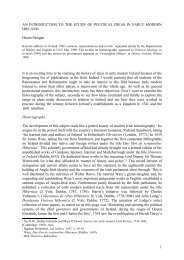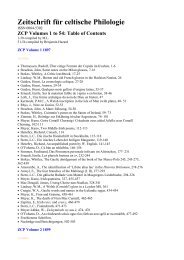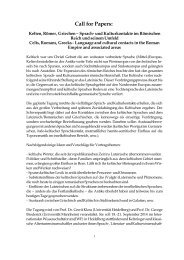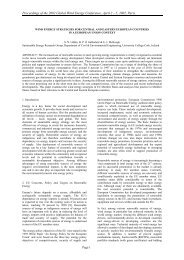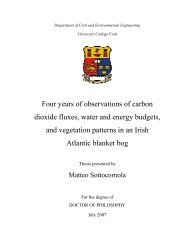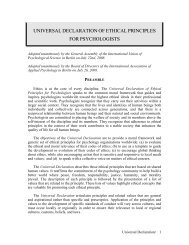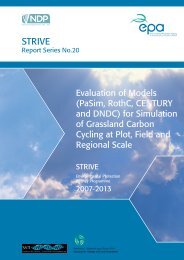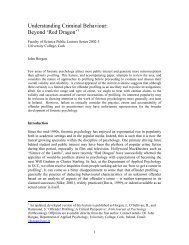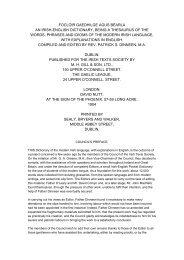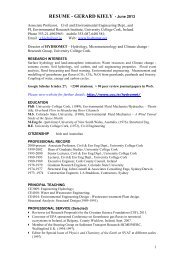PResident's RePORt 2009/2010 - University College Cork
PResident's RePORt 2009/2010 - University College Cork
PResident's RePORt 2009/2010 - University College Cork
Create successful ePaper yourself
Turn your PDF publications into a flip-book with our unique Google optimized e-Paper software.
Foreword<br />
UCC at a Glance<br />
Academic Developments<br />
Teaching and Learning<br />
Research<br />
<strong>College</strong> Reports:<br />
Arts, Celtic<br />
Studies and Social<br />
Sciences<br />
Business and Law<br />
Medicine and Health<br />
Science, Engineering and<br />
Food Science<br />
Events<br />
Student Experience<br />
Sports and Recreation<br />
Buildings and Estates<br />
<strong>Cork</strong> <strong>University</strong> Press<br />
Finance<br />
Governing Body<br />
IRIS Appendix<br />
74<br />
Flooding in November <strong>2009</strong> affected large areas to the<br />
west of <strong>Cork</strong> city<br />
Capital Development<br />
UCC’s capital programme, valued at over €400m, continued at<br />
pace during <strong>2009</strong>/<strong>2010</strong> with significant progress achieved on a<br />
number of key projects.<br />
The largest project of the current programme is the development<br />
of the Western Gateway Building. The building provides worldclass<br />
facilities for teaching and research in information technology<br />
and biomedical sciences. It has also enabled the consolidation of<br />
a number of academic units, including mathematics, computer<br />
science and SFI-funded information technology research<br />
groups, to a single location and provides incubation facilities<br />
for start-up software enterprises. The building houses lecture<br />
theatres with 1,400 seat capacity, state-of-the-art audio visual<br />
capability, high-specification computer facilities and specialist<br />
medical teaching and research laboratories. A pedestrian<br />
bridge and riverside walk link the site to the Brookfield Health<br />
Sciences Complex. Phase one (the lower three floors of the fivefloor<br />
building) was completed in July <strong>2009</strong> and the building was<br />
fully operational for the start of the <strong>2009</strong>/<strong>2010</strong> academic year.<br />
The upper two floors of the building will be fitted out as funding<br />
becomes available. Work was also completed on the 700m2<br />
PRTLI cycle 4-funded Cell Signalling/Cancer Research project.<br />
When it is completed, the overall investment in the project will<br />
exceed €100m.<br />
A €1m refurbishment of Áras na Laoi has significantly enhanced<br />
its teaching facilities, including a bespoke moot court for the<br />
Faculty of Law. The Department of Microelectronic Engineering<br />
has been relocated to the Electrical Engineering Building. The<br />
Department of Geology was moved to the North Mall to join<br />
the School of Biological, Earth and Environmental Sciences<br />
(BEES). A new Science and Technology Teaching and Learning<br />
Centre (STTLC) was established in the Kane Building to promote<br />
science and mathematics. The university has also significantly<br />
reduced its reliance on rented property.<br />
The €46m development of the Tyndall Research Institute at the<br />
Lee Maltings complex was completed in July <strong>2009</strong>. It is a major<br />
addition to Ireland’s capabilities in semi-conductor devices<br />
and materials research, especially at nanoscale. The sixfloor<br />
building incorporates a clean room suite and associated<br />
photonics, electronics and chemistry laboratories.<br />
The HEA’s Devolved Grant for Summer Works enables the<br />
university to address the ongoing maintenance deficit across<br />
the estate. Unfortunately no funding was received in <strong>2010</strong>, so<br />
the programme was limited as a result. A long-term annual<br />
programme is required to address this issue. UCC will continue<br />
to pursue the necessary funding.<br />
Planning approval has been secured for a new pedestrian bridge<br />
at Perrott’s Inch as part of the university’s privately-funded<br />
environmental plan. It is anticipated that construction will start<br />
in 2011.<br />
UCC was severely affected by the flood of 19/20th November<br />
<strong>2009</strong> that affected large areas in the west of <strong>Cork</strong> city. Serious<br />
damage was caused to 29 of UCC’s buildings. One-third of its<br />
estate was under water. One-quarter of its teaching facilities were<br />
destroyed. The facilities of 500 staff were seriously affected and<br />
over 2,000 students were evacuated from their accommodation.<br />
The extensive emergency response and recovery operations<br />
were completed within just 12 months of the flood. The swift<br />
response to this emergency meant that all teaching activities were<br />
back on track within one week. The refurbishment of the student<br />
accommodation complexes was completed by January. The<br />
Glucksman Gallery reopened its doors in January. The Mardyke<br />
Arena also reopened in February <strong>2010</strong>. All significant works will<br />
be completed by October 2011. The Office of Buildings and<br />
Estates has worked very closely with UCC insurers Aviva and<br />
loss adjustors OSG to agree the costs of the recovery works.<br />
In parallel, initial works have been implemented to mitigate the<br />
effect of any similar events in the future. Further works may be<br />
required pending the outcome of the Lee CFRAMS process.<br />
The support of <strong>Cork</strong> <strong>University</strong> Foundation for the university’s<br />
physical development plan is crucial to our capital programme.<br />
UCC has a relatively small land bank compared to other Irish<br />
universities. This creates significant pressure in accommodating<br />
the future development needs of the university. UCC continues<br />
to work with both the HEA and the local authorities to ensure<br />
the university is well positioned to meet its future development<br />
needs in a sustainable way.



